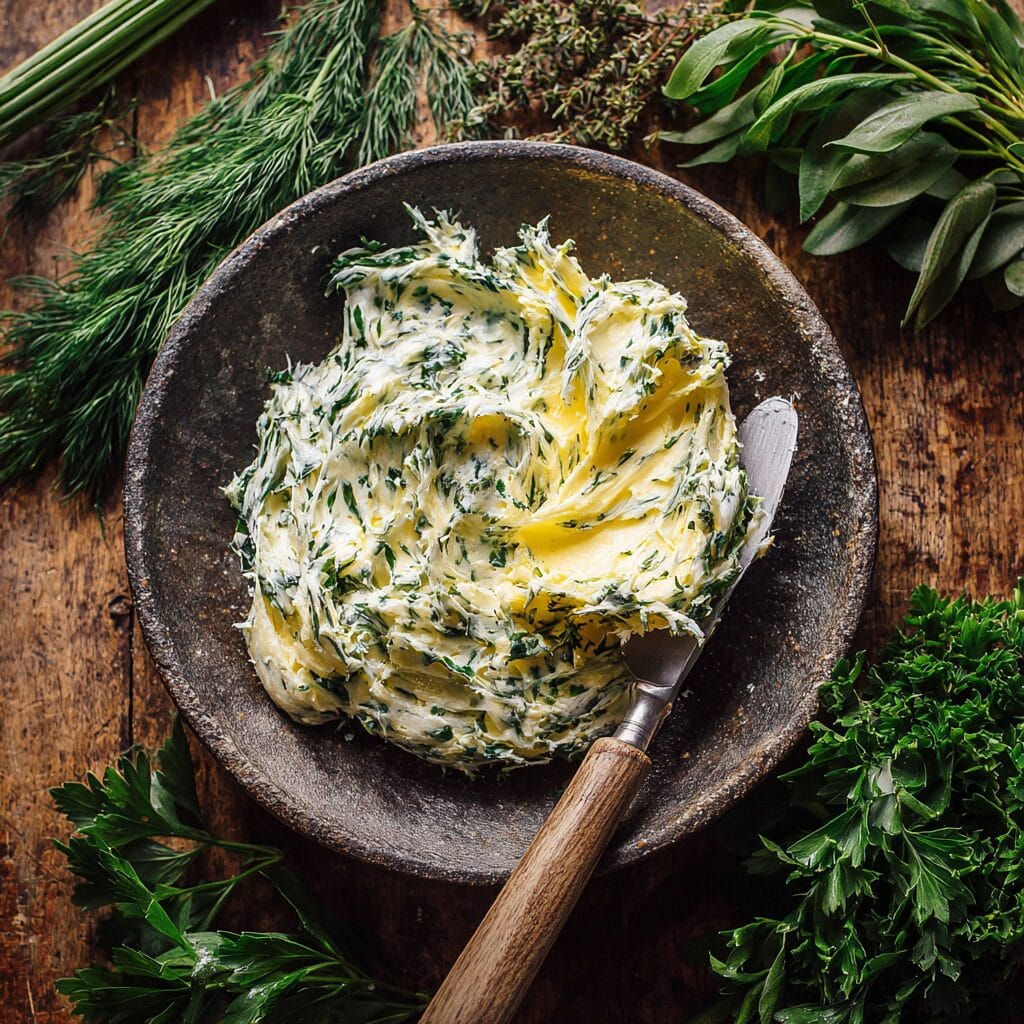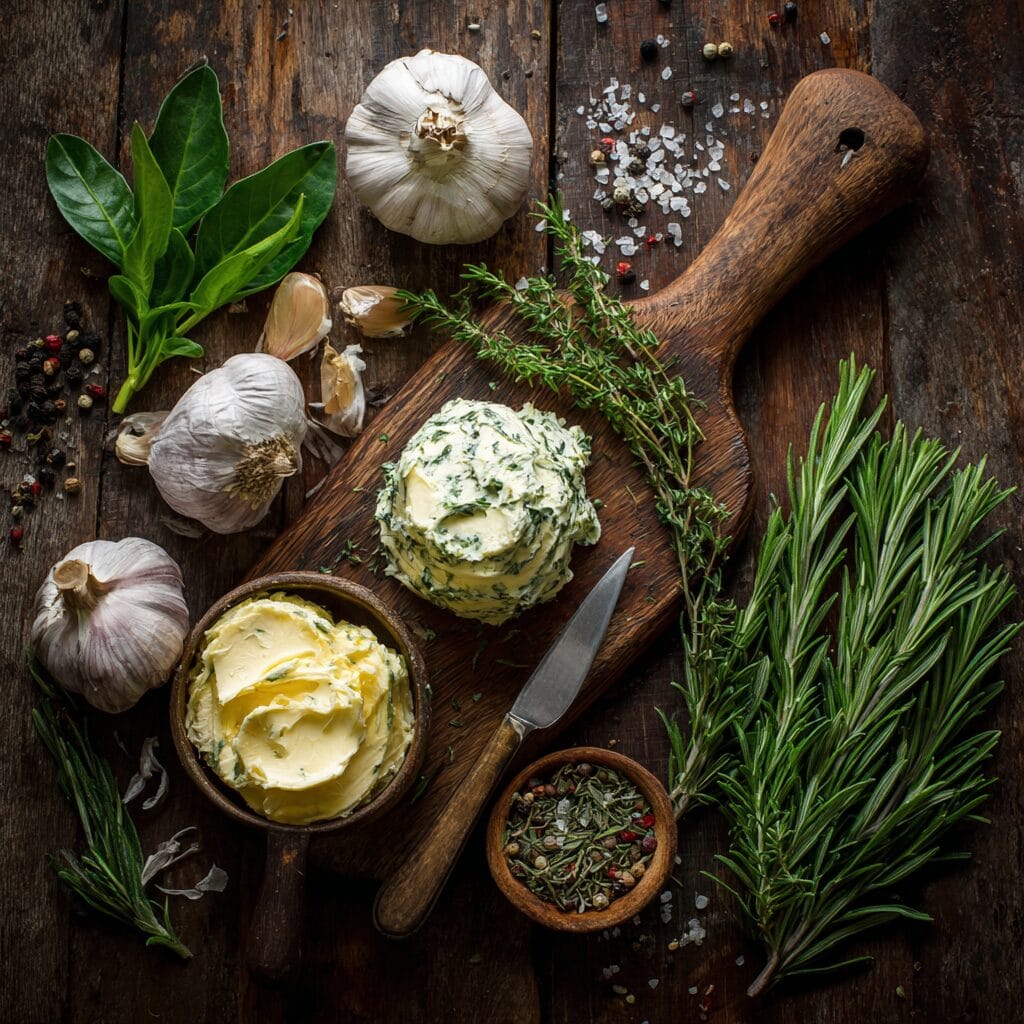
Gordon Ramsay Herb Butter
Ingredients
Equipment
Method
- Place softened butter in a bowl. 🗨️
- Add parsley, chives, tarragon, lemon zest, salt, and pepper. 🗨️
- Mix thoroughly with a spatula until herbs are evenly distributed. 🗨️
- Spoon butter onto plastic wrap, roll into a tight log, and twist ends. 🗨️
- Refrigerate at least 1 hour before slicing and serving. 🗨️
Nutrition
Notes
Tried this recipe?
Let us know how it was!Gordon Ramsay herb butter transformed my understanding of compound butters during my years cooking for the fire station crew. After watching the master himself demonstrate this technique on countless episodes, I knew I had to perfect this foundational skill that elevates everything from steaks to vegetables.
What started as curiosity about Ramsay’s passionate butter advocacy became an obsession with understanding why this simple combination creates such extraordinary results. Through trial and error in both professional and home kitchens, I’ve discovered the precise techniques that separate restaurant-quality herb butter from the bland, grainy versions most home cooks struggle with.
The FDA emphasizes proper herb handling for food safety, which becomes crucial when creating compound butters that preserve fresh ingredients for extended periods.
Ingredients That Actually Matter for Gordon Ramsay Herb Butter

Success with Gordon Ramsay herb butter depends entirely on three critical components: European-style butter with 82% fat content, perfectly dry fresh herbs, and proper seasoning balance. The higher fat content creates the silky texture Ramsay demands, while moisture-free herbs prevent separation and grittiness. Most home cooks fail because they use standard American butter (80% fat) and wet herbs, creating a grainy mess instead of the smooth, professional compound butter that makes Ramsay’s dishes legendary. Quality sea salt and fresh lemon zest provide the flavor foundation that transforms simple butter into liquid gold.
During my firefighting days, I discovered that Gordon Ramsay’s garlic bread techniques rely heavily on this same herb butter foundation, proving its versatility beyond steaks and seafood.
Understanding Gordon Ramsay’s Butter Philosophy
Why does Gordon Ramsay use so much butter? The answer lies in his classical French training, where butter serves as both flavor carrier and texture enhancer. Ramsay learned from Marco Pierre White and other French masters that butter isn’t just fat—it’s the vehicle that delivers herbs, seasonings, and aromatics directly to your palate while creating the luxurious mouthfeel that defines fine dining.
In professional kitchens, compound butters like Gordon Ramsay herb butter serve multiple purposes: they finish sauces, baste proteins, and add richness to vegetables. This efficiency explains why Ramsay reaches for butter constantly—it’s his Swiss Army knife for flavor enhancement.
The National Institutes of Health confirms that fat significantly impacts taste perception, validating Ramsay’s butter-heavy approach from a scientific perspective.
Essential Technique: Temperature Control
The secret to Gordon Ramsay herb butter lies in precise temperature management. Your butter must be exactly room temperature—soft enough to mix easily but firm enough to hold its shape. I learned this lesson the hard way when my first attempts created oily disasters because I rushed the softening process.
Remove butter from refrigeration 45 minutes before mixing. Test readiness by pressing gently—your finger should leave an impression without sinking completely. If you’re in a hurry, cut butter into small cubes and let sit for 15 minutes, but never use a microwave, which destroys the butter’s structure.
Fresh herbs require different preparation. Wash them gently, then pat completely dry with paper towels. Any residual moisture will cause your Gordon Ramsay herb butter to separate and develop an unpleasant grainy texture that no amount of mixing can fix.
The Professional Mixing Method
Gordon Ramsay’s technique involves specific mixing sequences that most home cooks overlook. Start by creaming the room-temperature butter with a wooden spoon—never electric mixers, which incorporate too much air and create a fluffy texture instead of the dense, smooth consistency professionals demand.
Add minced garlic first, working it completely into the butter base. This ensures even distribution and prevents harsh garlic pockets. Next, fold in finely chopped herbs using a gentle motion that preserves their cellular structure. Ramsay emphasizes that you’re coating herbs with butter, not pulverizing them.
Season with sea salt and fresh lemon zest last, tasting constantly to achieve the perfect balance. The mixture should taste slightly over-seasoned at room temperature because flavors mute when chilled.
This same careful technique applies to Gordon Ramsay’s tomato butter sauce, where proper emulsification creates restaurant-quality results.
Shaping and Storage Secrets
Professional presentation matters with Gordon Ramsay herb butter. Transfer your mixture to parchment paper, forming it into a log shape. Roll tightly, twisting the ends like a candy wrapper. This technique ensures uniform portions and maintains the butter’s integrity during storage.
Refrigerate immediately after shaping. Proper Gordon Ramsay herb butter firms up within two hours, developing the ideal consistency for slicing or spreading. For longer storage, wrap the parchment-covered log in aluminum foil to prevent freezer burn.
How long does herb infused butter last? When properly stored, Gordon Ramsay herb butter maintains peak quality for one week refrigerated or three months frozen. The key lies in preventing air exposure, which causes rancidity and flavor degradation.
Advanced Applications and Variations
Master chefs like Ramsay use compound butters strategically throughout service. Place a medallion of Gordon Ramsay herb butter on hot steaks during resting—the residual heat slowly melts the butter, creating a natural pan sauce. For vegetables, toss roasted or sautéed items with small amounts just before serving.
Seafood benefits enormously from herb butter finishing. The combination of herbs, garlic, and rich butter complements delicate fish flavors without overpowering them. I’ve seen this technique transform simple pan-seared fish into restaurant-worthy presentations.
Consider variations based on intended use: add fresh thyme for beef applications, tarragon for chicken, or dill for seafood. Each herb brings distinct characteristics that enhance specific proteins while maintaining the fundamental Gordon Ramsay herb butter technique.
The versatility extends to bread applications, where this compound butter elevates everything from Gordon Ramsay’s chip butty to elegant dinner rolls.
Professional Tips and Troubleshooting
Common mistakes plague home cooks attempting Gordon Ramsay herb butter. Over-mixing creates a greasy texture as the butter breaks and separates. Under-seasoning produces bland results that disappoint. Wet herbs cause separation and grittiness that ruins the entire batch.
If your butter becomes too soft during mixing, refrigerate for 10 minutes to firm up slightly, then continue. If it breaks and becomes oily, start over—there’s no salvaging broken compound butter.
Quality ingredients make the difference. European-style butter, preferably grass-fed, provides superior flavor and texture. Fresh herbs should be vibrant green without wilted edges. Garlic must be fresh—avoid pre-minced varieties that lack punch.
Professional kitchens often prepare large batches of compound butters during prep hours. Scale this recipe up for entertaining or meal prep, knowing that properly made Gordon Ramsay herb butter actually improves after a day of flavor melding.
FAQ
How does Gordon Ramsay make compound butter?
Ramsay combines room-temperature European butter with minced garlic, fresh herbs, sea salt, and lemon zest using gentle folding motions to preserve herb structure and create smooth texture.
What are 5 interesting facts about Gordon Ramsay?
He trained under Marco Pierre White, holds 16 Michelin stars, was a soccer player before cooking, runs 58 restaurants globally, and earned a black belt in karate.
How long does herb infused butter last?
Properly stored Gordon Ramsay herb butter lasts one week refrigerated or three months frozen when wrapped in parchment and aluminum foil to prevent air exposure.
Why does Gordon Ramsay use so much butter?
Ramsay’s French training taught him that butter carries flavors, enhances textures, and creates the luxurious mouthfeel essential to fine dining presentations and sauce work.
Final Thoughts
Mastering Gordon Ramsay herb butter requires patience, quality ingredients, and attention to detail that separates professional results from amateur attempts. This foundational technique opens doors to countless culinary applications, from finishing steaks to elevating simple vegetables into memorable sides.
The investment in proper European butter and fresh herbs pays dividends in flavor and presentation. Your family and guests will notice the difference immediately—that restaurant-quality richness that makes every bite special.
Remember that Mayo Clinic research shows that moderate amounts of quality fats like butter can be part of a balanced diet, making this indulgent technique guilt-free when used appropriately.
Start with this basic Gordon Ramsay herb butter recipe, then experiment with variations that complement your favorite proteins and vegetables. The technique remains constant—only the herb combinations change.
Stay safe,
Jack Sullivan


